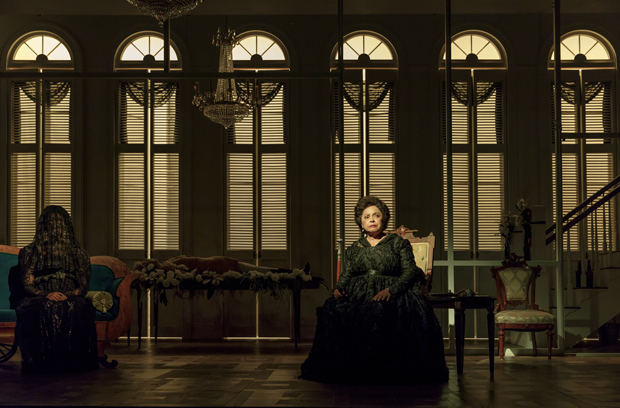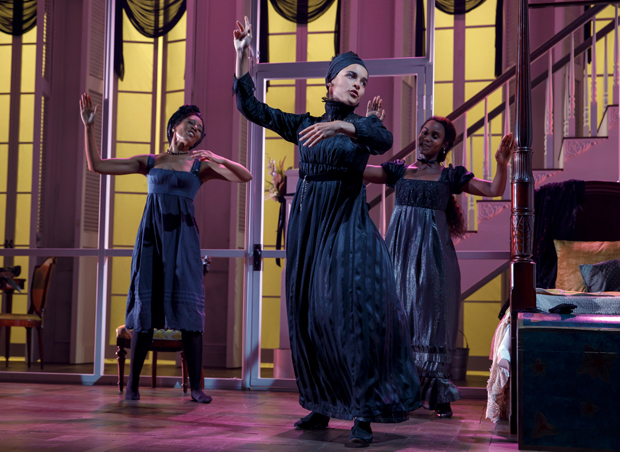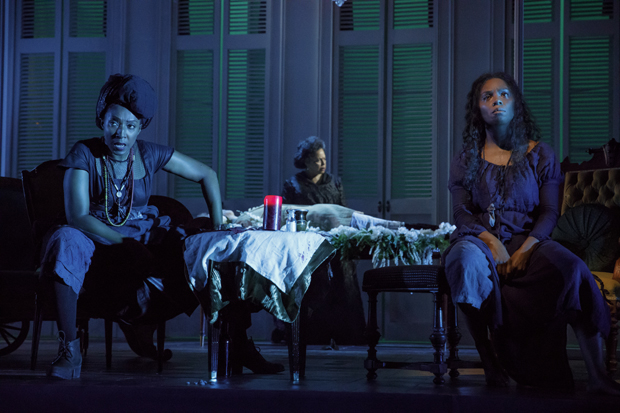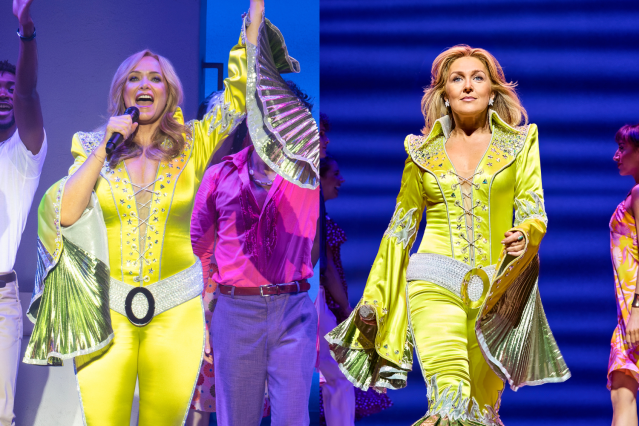The House That Will Not Stand Exposes Largely Forgotten History
Marcus Gardley’s new play takes place during the transfer of Louisiana from France to the United States.

(© Joan Marcus)
Crystal chandeliers flicker against a phalanx of tall, thin shuttered windows in The House That Will Not Stand, Marcus Gardley's new play at New York Theatre Workshop. Masterfully realized by set designer Adam Rigg, this Southern Gothic decadence is only enhanced by the gardenia-bedecked corpse laid out on a sideboard. Inspired by Federico Garciá Lorca's The House of Bernarda Alba, the play tells the story of a family of free women of color living in New Orleans on the eve of the transfer of power from France to the United States following the Louisiana Purchase.
Gardley is the author of X: or, Betty Shabazz v. The Nation, a play that The House That Will Not Stand fails to match in either its rigor or insight. Between its supernatural tone and outsize feminine sexuality, the play often verges on camp (as all entertaining versions of Bernarda Alba inevitably do). While Gardley's storytelling occasionally digresses, he still proves himself one of the great theatrical practitioners of historical fiction by depicting a little-discussed era of American history. More thrillingly, he brings something to the stage completely alien to most viewers: The story of a black family that owns a black slave.

(© Joan Marcus)
That wouldn't have been so novel for the early 19th-century residents of New Orleans, a place that was (and still is) governed by a complex web of racial and class hierarchies developed at the nexus of the Caribbean and continental United States. The corpse on the credenza is Lazare Albans, the former man of the house and the white father to three women of color: Agnès (Nedra McClyde), Maude Lynn (Juliana Canfield), and Odette (Joniece Abbott-Pratt). Their mother is Beartrice (Lynda Gravátt), who is not Lazare's wife, but his placée (a contractually recognized black mistress). Lazare has left everything to Beartrice in his will, but the inheritance is cast into doubt when the new American government refuses to recognize their relationship.
That's bad news for Makeda (Harriett D. Foy), the family slave to whom Beatrice has promised freedom once she is legally in control of the estate. No one delights more at the prospect of Beartrice's ruin than her best frenemy La Veuve (Marie Thomas). Agnès tries to convince her sisters that they must become placées themselves in order to secure their futures, but Beartrice is hell-bent on preventing her daughters from having to sell themselves the way she did. Meanwhile, her allegedly insane sister, Marie Josephine (Michelle Wilson), haunts the upper floors.

(© Joan Marcus)
Wilson is fabulously spectral in this Cassandra-like role. Her scenes with the funny and fierce Foy are some of the best. McClyde, Canfield, and Abbott-Pratt exhibit an authentically sororal energy (which is to say, not all hugs and kisses). McClyde and Abbott-Pratt are particularly delicious to watch as their characters subtly undermine each other.
As their mother, Gravátt gives the standout performance of the show: Stinging rebukes delivered through the thick molasses of her diction, she is every bit the picture of a rough woman who clawed her way into comfort, like a female version of Big Daddy in Cat on a Hot Tin Roof. She won't surrender that privilege without a fight. Even when she is compelled by the script to speak some of Gardley's more contrived lines (like a passage in which she schemes to win over Lazare's estranged wife with her sex), Gravátt is 100 percent believable in her role.

(© Joan Marcus)
Like a practitioner of theatrical voodoo, director Lileana Blain-Cruz succeeds at conjuring an ideal atmosphere for magic and mayhem. That starts with Rigg's set, but continues through Montana Levi Blanco's outrageously over-the-top mourning costumes. This ghost story really comes alive, however, when lighting designer Yi Zhao and sound designer Justin Ellington convincingly create a summer storm just beyond the set's three walls, sealing us in with these ghosts from the past. Makeda closes the shutters against the approaching metaphor, but we suspect that it won't be enough to protect this old house, whose fate is betrayed in the title.
We are still captivated by how that fate comes to pass, at least until the story begins to sag in the second act following an unnecessary interval (as much as it pains me to say, this play could benefit from the two-hour-no-intermission treatment). Still, there is something delightfully old-fashioned about Gardley's dramaturgy and the way he approaches a rich family living in a big house on the precipice of immense change. That is a story that never seems to go out of style.







